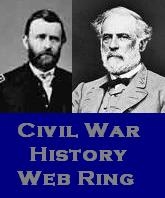 |
| Robertson's Battery of Horse Artillery (B&L 2nd Artillery) |
Battery
|
Captain (on muster rolls)
|
Actual Commander
|
Gun Type
|
Division/Corps assignment at Antietam
|
E&G First Artillery
|
1LT Alanson Randol (USMA 1860)
|
4-12 lb Napoleons
|
Sykes Division Fifth Corps
|
|
I First Artillery
|
James Ricketts (USMA 1839)[3]
|
1LT George Woodruff (USMA June 1861)
|
6-12 lb Napoleons
|
Sedgwick’s Division, Second Corps
|
K First Artillery
|
William Graham[4]
|
CPT William Graham
|
6-12 lb Napoleons
|
Artillery Reserve
|
A Second Artillery
|
John C. Tidball (USMA 1848)
|
CPT John C. Tidball
|
6-3" Ordnance Rifles
|
Horse Artillery Cavalry Division
|
B&L Second Artillery
|
James W. Robertson (Company B) William Hays (USMA 1840- Company L)[5]
|
CPT James W. Robertson
|
4-3" Ordnance Rifles
|
Horse Artillery Cavalry Division
|
D Second Artillery
|
Edward R. Platt (USMA 1849)[6]
|
1LT Edward Williston
|
6-12 lb Napoleons
|
Slocum’s Division, Sixth Corps
|
E
Second Artillery
|
Josiah H. Carlisle (USMA 1845)[7]
|
1LT Samuel Benjamin (USMA May 1861)
|
4-20 lb Parrot Rifles
|
Willcox’s Division Ninth Corps
|
G Second Artillery
|
James Thompson (USMA 1851)[8]
|
1LT John H. Butler
|
4-12 lb Napoleons
|
Couch’s Division Fourth Corps
|
M Second Artillery
|
Henry Benson[9]
|
1LT Peter Hains (USMA June 1861)
|
6-3" Ordnance Rifles
|
Horse Artillery Cavalry Division
|
C&G Third Artillery
|
Horatio Gibson (USMA 1847 Company C)
Alexander Piper
(USMA 1851 Company G)[10]
|
CPT Horatio Gibson
|
6-3" Ordnance Rifles
|
Horse Artillery Cavalry Division
|
L&M Third Artillery
|
Dunbar Ransom (Company L)[11]
John Edwards (USMA 1851-Company M)
|
CPT John Edwards
|
4-10 lb Parrot Rifles
|
Cox’s Division, Ninth Corps
|
A&C Fourth Artillery
|
Francis N. Clarke (USMA 1840 Company A)[12]
George Hazzard (USMA 1847)[13]
|
1LT Evan Thomas
|
6-12 lb Napoleons
|
Richardson’s Division, Second Corps
|
B Fourth Artillery
|
John Gibbon (USMA 1847)[14]
|
1LT Joseph Campbell (USMA June 1861)[15]
|
6-12 lb Napoleons
|
Doubleday’s Division, First Corps
|
E
Fourth Artillery
|
Joseph C. Clark (USMA 1848)
|
CPT Joseph C. Clark
|
4-10 lb Parrot Rifles
|
Sturgis Division, Ninth Corps
|
F Fourth Artillery
|
Clermont Best (USMA 1846)[16]
|
1LT Edward D. Muhlenberg
|
6-12 lb Napoleons
|
Twelfth Corps
|
G Fourth Artillery
|
Albion Howe (USMA 1841)[17]
|
1LT Marcus P. Miller (USMA 1858)[18]
|
6-12 lb Napoleons
|
Artillery Reserve
|
A
Fifth Artillery
|
George Getty (USMA 1840)[19]
|
1LT Charles P. Muhlenberg
|
6-12 lb Napoleons
|
Rodman’s Division, Ninth Corps
|
C
Fifth Artillery
|
Dunbar Ransom
|
CPT Dunbar Ransom
|
4-12 lb Napoleons
|
Meade’s Division, First Corps
|
D
Fifth Artillery
|
Charles Griffin (USMA 1847)[20]
|
1LT Charles Hazlett (USMA May 1861)
|
4-10 lb Parrots 2-12 lb Napoleons
|
Morell’s Division, Fifth Corps
|
F
Fifth Artillery
|
Romeyn Ayres (USMA 1847)[21]
|
1LT Leonard Martin (USMA May 1861)
|
4-10 lb Parrots 2-12 lb Napoleons
|
Smith’s Division, Sixth Corps
|
I Fifth Artillery
|
Stephen Weed (USMA 1854)
|
CPT Stephen Weed
|
4-3" Ordnance Rifles
|
Syke’s Division, Fifth Corps
|
K
Fifth Artillery
|
John R. Smead (USMA 1854)[22]
|
2LT William E. Van Reed
|
4-12 lb Napoleons
|
Syke’s Division, Fifth Corps
|










